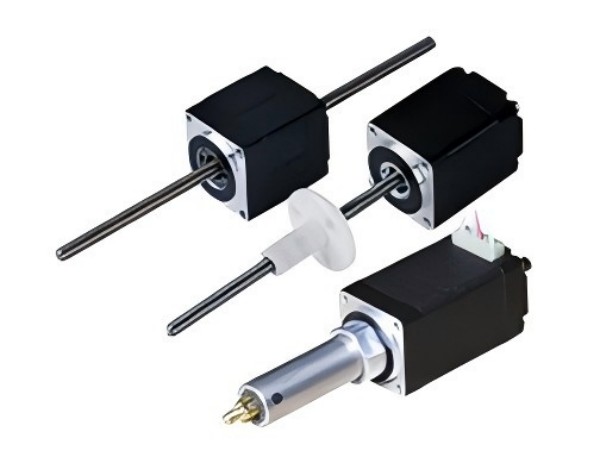In recent years, the advancements in motion control systems have led to the development of two crucial types of motors: the hybrid synchronous stepper motor and the hybrid servo stepper motor.
Both types have distinct characteristics and applications, but understanding their key differences can help engineers and designers select the right motor for specific applications. This detailed comparison explores the differences in performance, efficiency, and applications, and provides a clear guide to choosing between the two.

What is a Hybrid Synchronous Stepper Motor?
Stepper motors that combine the features of variable reluctance and permanent magnet stepper motors are known as hybrid synchronous stepper motors. It operates using a fixed magnetic field generated by the stator, which interacts with the rotor’s magnetic field to produce precise incremental movements. The motor’s step angle is fixed, meaning the rotor moves in small, discrete steps.
Generally speaking, hybrid synchronous stepper motors are made for uses requiring precise placement and dependable operation. Common uses include CNC machines, robotics, and various precision tools. These motors are widely used because they offer high torque at low speeds, making them ideal for tasks requiring constant movement without slippage.
What is a Hybrid Servo Stepper Motor?
On the other hand, a hybrid servo stepper motor integrates a stepper motor with a servo control system, offering both precision and continuous feedback to control motion more accurately than traditional stepper motors. This hybrid motor has the benefits of closed-loop feedback systems, making it a more efficient choice for high-performance applications.
A hybrid servo stepper motor uses a combination of a stepper motor’s fixed steps and the servo’s dynamic control to ensure smooth operation with minimal errors. Usually, these motors are employed in situations where power efficiency, speed control, and dynamic performance are essential. Examples include automated assembly lines, packaging machines, and advanced robotics.
Important Distinctions Between Hybrid Servo Stepper Motors and Hybrid Synchronous Stepper Motors
| Feature | Hybrid Synchronous Stepper Motor | Hybrid Servo Stepper Motor |
| Control Type | Open-loop or closed-loop | Closed-loop |
| Precision | Fixed step angles | Dynamic, continuous feedback |
| Efficiency | Moderate, may have more heat generation | Higher efficiency, lower heat loss |
| Torque | High torque at low speeds | High torque with smooth control at all speeds |
| Speed | Limited by step angle and driver | Faster response with smooth motion |
| Power Consumption | Can be higher at low speeds | Generally more efficient with power |
| Applications | CNC machines, 3D printers, robotics | Packaging machines, conveyors, advanced robotics |
| Cost | Less expensive | Higher cost due to integrated control system |
Advantages of Hybrid Synchronous Stepper Motors
- Cost-Effective: Hybrid synchronous stepper motors are less expensive compared to their hybrid servo counterparts. Their simple design and open-loop control make them a more budget-friendly option for standard applications.
- Reliable Torque at Low Speeds: These motors have exceptional torque at low speeds, which is crucial for applications like CNC or 3D printing systems that need steady power with little variation.
- Simplicity: The open-loop system design allows for ease of use and less complexity, making it easier to set up and troubleshoot.
Advantages of Hybrid Servo Stepper Motors
- Higher Efficiency: Hybrid servo stepper motors feature closed-loop control, which allows them to adjust dynamically to load conditions, improving efficiency and reducing power consumption.
- Precise Speed Control: These motors provide precise and smooth speed regulation, which is crucial in applications where variable speeds and load conditions are involved.
- Better Heat Management: Due to the feedback system, hybrid servo motors tend to produce less heat during operation, making them ideal for high-performance, continuous use applications.
- Improved Performance: The continuous feedback of a hybrid servo stepper motor ensures more accurate and stable motion, making it suitable for highly sensitive applications where precision is critical.
Applications of Hybrid Synchronous Stepper Motors
- CNC Machines: Hybrid synchronous stepper motors are widely used in CNC machining applications due to their ability to handle precise movements and work at low speeds.
- 3D Printers: These motors provide the precise control required for 3D printing applications, where accuracy in layer deposition is paramount.
- Robotics: When precise incremental movements are necessary for tasks such as robotic arm control, hybrid synchronous stepper motors offer a reliable solution.
Applications of Hybrid Servo Stepper Motors
- Packaging Machinery: The hybrid servo stepper motor is ideal for applications such as high-speed packaging systems where speed and accuracy are essential.
- Conveyor Systems: These motors are ideal for factory conveyor belt systems because they offer precise torque and speed control.
- Advanced Robotics: Hybrid servo stepper motors excel in robotics where precise, continuous motion is necessary for high-performance tasks.
Conclusion
Both hybrid synchronous stepper motors and hybrid servo stepper motors bring unique benefits to different types of applications. Hybrid synchronous stepper motors are ideal for cost-effective, low-speed precision tasks, while hybrid servo stepper motors excel in high-performance, dynamic systems requiring constant feedback and efficiency.
The final decision between these two motor types is based on the particular needs of the application, including budgetary restrictions, speed, accuracy, and power efficiency. Comprehending these distinctions guarantees that engineers can choose the best motor for their system with knowledge.

